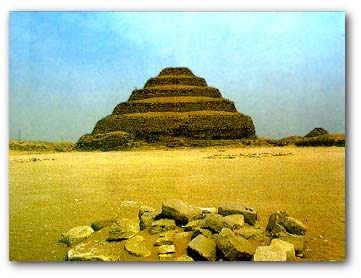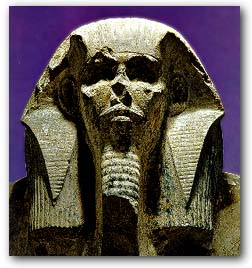The Step
Pyramid of
Djoser (Zoser)

Across the Great Court of the Pyramid Complex of Djoser (Zoser) (2667 - 2648 BC),
the second king of the 3rd Dynasty, stands the Step
Pyramid. It is believed to have been created by one
man, Imhotep. He has been called Doctor, Sage, Architect,
Astronomer and High Priest. During an excavation in
1924-26, a pedestal of a statue of Djoser (Zoser) was
found. This complex represents the first major work in
stone. That is, unless there are other works that have
yet to be found.

On the Pyramid, most of the outer casing is gone. In
some places the core masonry has disappeared as well. It
is obvious there were different stages of construction.
The eastern side gives the best picture, but it can be
seen from the northern and southern side as well.
The original structure was an underground burial
chamber. This chamber was rare in that it was square;
most mastabas were rectangular. The royal tomb is 28m
underground with a vertical shaft leading to it. The
entrance was sealed with a 3 ton piece of granite. The
face of the mastaba was a fine Tura limestone. Apparently
it was intended for this to be the finishing touches to
the building. It was then enlarged all around with ten
feet of additional limestone and then again with an
extension on the eastern side. The extension was
twenty-five feet of limestone to make the mastaba
rectangular. Again, it was enlarged and a two-tiered
structure was made. A series of corridors and a tomb
chamber was dug. Some of the chambers are lined with blue
tiles. Some scholars think this tomb was intended for a
member of Djoser's (Zoser's) family, but not for him. The
only other site that has similar tiling is in the South
Tomb which is located in the Djoser (Zoser) complex as
well.
After the third stage was finished, the process to
make it a true step pyramid was begun. Over 200,000 tons
of stone was used to make the additional two tiers that
went above the existing two-tiered structure. An
additional two tiers were added above the existing four
to make it into the six-tiered pyramid which is there
today. A Tura limestone face was added on.
On the northern side of the pyramid, a few blocks of
the casing remain. The casing blocks from the Great
Pyramid rested on the individual blocks of the core
masonry. The casing blocks on the step pyramid were set
at an angle to take up the thrust of the successive
layers.
The statue of Djoser (Zoser) that was found by
excavators, was found in the Tomb Chamber. This statue
was damaged but still intact. It is located in the Cairo
Museum. The Tomb Chamber has a replica of the statue in
this blue-tiled room. It can still be seen through the
viewing slit that is at the entrance. The chamber is
closed to the public. Scholars believed that the roof of
the chamber could give way. The chamber walls have
inscriptions that show beyond any doubt that this is
indeed a burial chamber. It also contains offering rooms
and most of the other features that were often found in
both earlier and later tombs.
The Mortuary Temple is just north of the pyramid and
is in total ruin. On the southern wall back across the
Great Court from the pyramid are carved cobra heads or
uraei. The cobra head is an often seen symbol in Egypt.
It was once a symbol of the north.
The Southern Tomb is located just outside of the
southern wall. Steps lead up the wall to the other tombs
and monuments outside the walls. On the left side of the
stairs, there is a large hole. At the bottom of the hole,
is an entrance that leads to an amazing set of chambers.
This Southern Tomb is closed to the public. These
chambers are also lined with the blue tiles that are
found in the burial chambers in the Step Pyramid. The
inscriptions found in these chambers are remarkable. They
are perfectly executed and pure in line.
|





